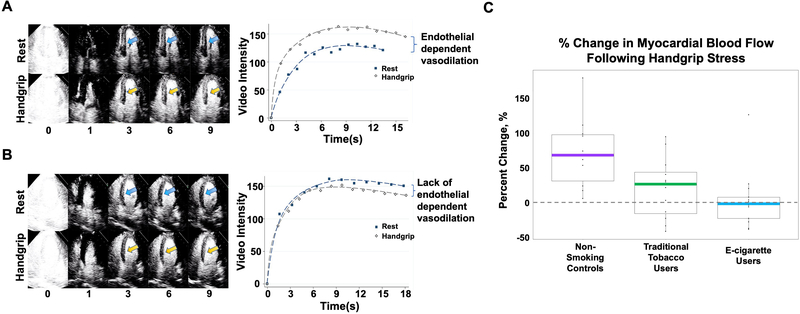E-cigarettes deliver with each inhalation a bolus of poorly-characterized small molecules that have been linked to direct lung injury, can cross the alveolar-capillary barrier, and cause potential harm to other end-organs.
To understand the possible cardiac effects, we studied N=35 adults free of chronic disease (age 28±5 years, 26% female): self-reported non-smoking controls, exclusive e-cigarette users (mean e-cigarette use 3±2 years), and exclusive tobacco cigarette smokers (mean smoking history 9±3 years). Following overnight inhalant abstinence, participants underwent myocardial contrast echocardiography (MCE) to quantify myocardial blood volume (MBVol), microvascular flux rate (□), and blood flow (MBF).1 We fit acoustic intensity timeplots to the function y=MBVol*(1-eβt), with y representing acoustic intensity at time (t) and β denoting mean rate at which blood passes through microcirculation; we calculated myocardial blood flow (MBF)=(MBVol)*(β). We conducted MCE before and after isometric handgrip exercise stress (Figure),2 which normally increases myocardial work and coronary endothelial-dependent vasodilation. We used Wilcoxon rank sum test for between-group and Wilcoxon signed-rank test for within-group comparisons (STATA v15.1). Our institutional review board approved all protocols; all participants provided written informed consent.
Figure.
30-year-old healthy non-smoker, myocardial contract echocardiography shows increase in septal myocardium perfusion (A); in a 33-year-old apparently healthy e-cigarette user, post-stress perfusion is blunted, indicating impaired endothelial-dependent vasodilation (B). Across our study sample (C), blunted post-stress myocardial blood flow in e-cigarette users was comparable to that seen in conventional cigarette users, driven more by attenuated myocardial flux rate than blood volume response (for details, see biodatacore.org\projects\circres2020).
All de-identified study data are available at biodatacore.org\projects\circres2020.
At rest, MBVol was higher in tobacco users than in non-smoking controls (P=0.048) and there were otherwise no between-group differences in MBVol, β, or MBF. Under normal conditions, modest exercise stress induces physiologic increases in MBF by augmenting β with smaller degrees of increase in MBVol (Figure). Accordingly, in non-smoking controls, we observed a post-stress increase in β and MBF (95±13 to 153±16 IU/s, P=0.005). In tobacco users, stress also increased β, to a smaller degree than in controls, but induced no change in MBVol or MBF (102±13 to 118±14 IU/s, P=0.18). In e-cigarette users, stress induced no change in MBVol, β, or MBF (74±8 to 70±8 IU/s, P=0.51). E-cigarette use compared to tobacco smoking was associated with lower MBFpost-stress in males but higher MBFpost-stress in females; however, the sex interaction was not significant (P=0.07). There was no effect modification by age or body mass index.
We found evidence of coronary microvascular endothelial dysfunction in e-cigarettes users that was at least similarly severe when compared to conventional cigarette smokers. We observed these effects in apparently healthy young adults, and despite e-cigarette use being only recently popularized and conventional cigarette users having a longer prior tobacco exposure. In conventional smokers, blunting of the myocardial perfusion response to stress corresponded with a relative inability to augment blood volume – in the setting of increased blood volume at baseline, potentially related to longer-standing tobacco exposure. By contrast, in e-cigarette users, blunting of the myocardial perfusion response to stress corresponded with inability to augment both myocardial blood flow and volume. Although unmeasured in this study, our findings in e-cigarette users could be related to oxidative stress, myocardial diastolic dysfunction, and variability in vape device- or user-related factors. Further studies are needed, including those using higher-resolution imaging techniques, to further investigate e-cigarette effects on cardiac and vascular physiology. While the longer-term cardiovascular effects of e-cigarette use remain unclear, our findings support the need for ongoing investigations into their safety profile.
Acknowledgments
SOURCES OF FUNDING
California Tobacco-Related Disease Research Program grant 22XT-0017.
Footnotes
DISCLOSURES
None.
DEDICATION
We dedicate this work to memory of Dr. Ronald G. Victor.
A prepublished version of the letter can be found at Medrxiv: https://www.medrxiv.org/content/10.1101/2020.01.16.20017780v1.
REFERENCES
- 1.Nelson MD, Rezk-Hanna M, Rader F, et al. Acute Effect of Hookah Smoking on the Human Coronary Microcirculation. Am J Cardiol 2016;117:1747–54. [DOI] [PMC free article] [PubMed] [Google Scholar]
- 2.Jake Samuel T, Beaudry R, Haykowsky MJ, Sarma S, Park S, Dombrowsky T, Bhella PS, Nelson MD. Isometric handgrip echocardiography: A noninvasive stress test to assess left ventricular diastolic function. Clin Cardiol 2017;40:1247–1255. [DOI] [PMC free article] [PubMed] [Google Scholar]



